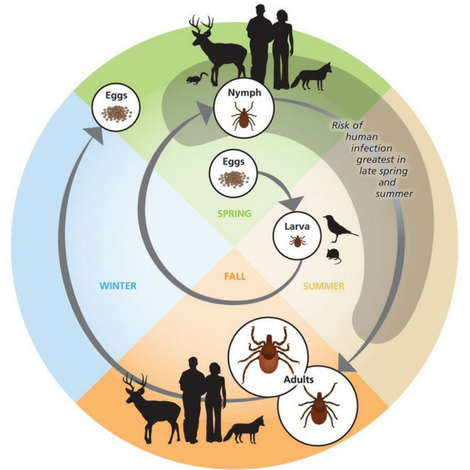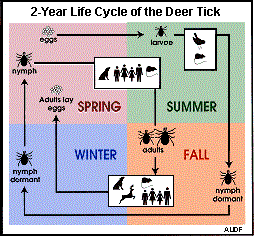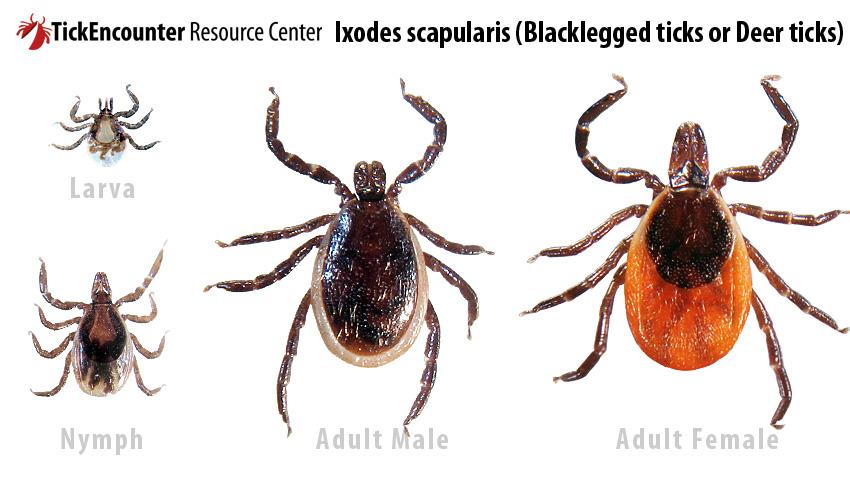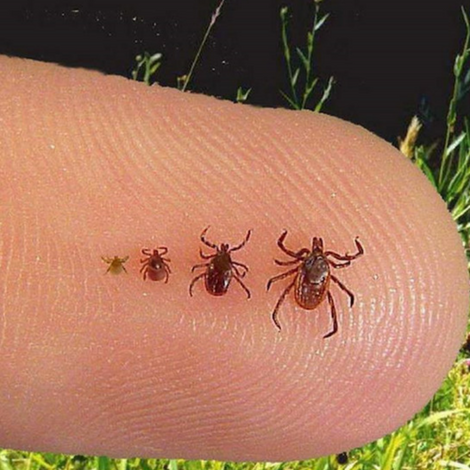tick life cycle canada
1 The Egg Stage 1 After the adult female tick has acquired a proper blood meal she mates with the adult male tick leaves the host and searches for a suitable spot to lay her eggs. The life cycle of ticks Eggs.
Tick Control And Disease Prevention Deerbusters Canada
Ticks have a two year life cycle.

. Hoary Tick-trefoil Canada Tick-clover. Ticks lifecycle begins at the egg stage then proceeds to the larval stage nymphal stage and lastly the adult. In early spring ticks begin to lay their eggs.
Two of the most common types are Black Legged ticks formerly know as the Deer Tick and the American Dog tick. Female ticks lay thousands of eggs on the ground which then hatch into larvae known as seed ticks. They need the dry to die.
The majority of hard ticks require three different hosts to complete their development. Ixodes scapularis the black-legged deer tick which is the primary vector for Lyme disease has a four-stage life cycle and a lifespan of about two years. It must have a blood meal in each phase to move on to the next.
This is the safest way to handle your outdoor clothing as ticks can survive a full cycle in the washing machine. Egg six-legged larva eight-legged. Life Cycle of Ticks.
Check the whole body. During this time they go through four life stages. In Canada you will most likely spot the black-legged breed popularly known as the deer tick.
Ticks can transmit disease such as Lyme to animals and people when. Stages in the Life Cycle of Ticks. DO THE TICK CHECK Ticks prefer warm moist dark areas of the body.
The tick requires a blood meal to evolve into each stage of its life. Prairies along shores along roads railroads open woods. On average tick eggs hatch after about 2 weeks though it can take as long as 6 weeks or as little.
Now let us look at their life cycle to get a better understanding. These stages are egg larvae or seed tick nymph and adult. A female tick is capable of laying more than a thousand eggs.
The eggs hatch and six-legged larvae emerge from the eggs. Deer Tick Life Cycle and Active Periods Tick Eggs 1. Generally adult female hard ticks breed while on the host animal and then drop to the ground to lay eggs.
Deer tick eggs hatch into larvae in the late summer months during which time they take one blood meal from a small mammal or bird. Ticks have 4 distinct stages to their life cycle. Ticks have 4 life stages.
Egg larva nymph and adult. After hatching the newly-born tick larva requires a blood meal to advance to the next stage of life as a six-legged nymph. Its important to be familiar with this life cycle to get rid of ticks from your lawn and landscape and prevent tick bites.
The life cycle of black-legged ticks normally lasts from two to three years depending the availability of food and other factors. 2 to 6 feet. The Ixodes scapularis ticks that transmit Lyme disease in Eastern regions of the United States and Canada have a two-year life cycle.
Dermacentor variabilis is a three-host-tick with each stage of the life cycle larvae nymphs and adults feeding on a separate host. During this development ticks go through four stages of life. Each stage of the life cycle requires a blood meal to develop and eggs typically hatch into six-legged larvae after a period of four to 10 days.
See also How To Tell A Tick From A Spider. The life cycle of a deer tick lasts about two years and begins in the early spring when an adult female engorged full with blood lays fertilized eggs. The blacklegged tick or deer tick Ixodes scapularis is one of the most important ticks in the Northeast for human and animal health.
The First Stage egg The adult female tick first fulfills a proper blood meal then the process of mating occurs between an adult male and adult female tick. Lets review the life-cycle of a tick. Ticks begin questing looking for a blood meal when temperatures reach 4oC and higher.
After a two-year life cycle a female tick can lay thousands of eggs. Ticks begin their lives as eggs. Female adult groundhog ticks will drop off the host and lay eggs after feeding then die.
Depending on the tick species and its stage of life preparing to feed can take from 10 minutes to 2 hours Ixodes Life Cycle The lifecycle of blacklegged ticks Ixodes scapularis and Ixodes pacificus generally lasts two yearsDuring this time they go through four life stages. They can be found across the eastern half of the United States and into southern portions of. Black Legged ticks are the common vector for Lyme Disease.
Ticks are not able to lay eggs directly on a host they must first detach. Average to moist sandy or rocky soil. These are spherical slightly translucent dark brown in color and are laid in clusters of up to 3000 individuals.
All ticks whether they are hard or soft undergo four developmental stages namely egg larva nymph and adult. These eggs are the first of the four distinct life stages that make up the tick life cycle. Egg larvae nymph and adult.
At this stage of life these small ticks about 18-inch in size have six legs instead of the eight legs they will have later on in their lives. Eggs are not dangerous and. A hot room or on a hot windowsill.
The lifecycle of Ixodes pacificus ticks generally lasts three years. After attaching to its host and feeding the tick will drop off the host and molt into its next phase. After the eggs hatch the ticks must have a.
The female tick then leaves the host and. There are dozens of different tick species that are commonly found across Canada. Blacklegged ticks are common species and the primary vectors for Lyme disease Anaplasmosis Babesiosis and other illnesses.
Female adults die after egg-laying is complete. The ticks need a new host at each stage of their life. Inside or out ticks love a warm environment to lay their eggs.
Adults will seek out mates on their third and final hosts. Dermacentor variabilis the American dog tick is a large reddish-brown ornate hard tick. Egg larva nymph adult.
Fabaceae Pea Life cycle. It begins in early spring when adult females lay eggs on the. A tick goes through a similar life cycle as other arthropods as the metamorphosis starts at the egg stage moves to larval stages then to the nymphal stage and finally to adult.
In Canada it is found from Alberta east to Nova Scotia and has increasingly pushed west and north in the last decades. Egg Larvae Nymph and Adult. However they can lay eggs just about anywhere else and they do.
The process begins in spring when an adult female deposits eggs onto the ground. It may be helpful to have someone else. The life cycle of a tick is completed after four stages namely egg larva nymph and adult it requires more than a year to complete a full life cycle.
At each stage ticks require a blood meal to survive and develop. Ticks come in various sizes and shapes based on the stage of life they are at. Ticks are found in many areas across Canada including southern Ontario.
The ticks will dry out and die within 24 hours. The Tick or the Egg. The tick feeding process makes ticks very good at transmitting infection.

Typical Life Cycle Of The Blacklegged Tick Ixodes Scapularis And Download Scientific Diagram

The Typical Life Cycle Of The Black Legged Or Deer Tick Ixodes Download Scientific Diagram

Ticks In The Carp Hills Friends Of The Carp Hills
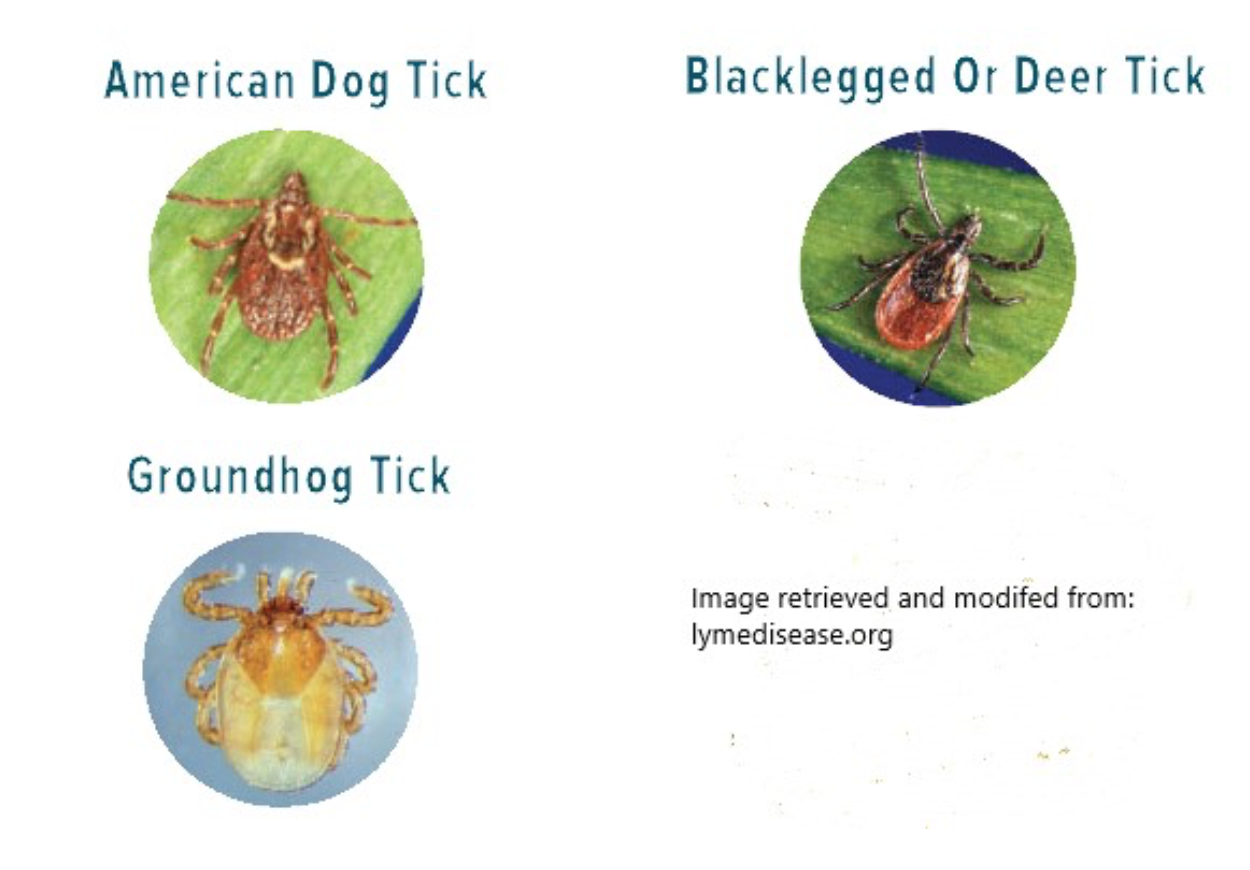
Ticks Lyme Disease And Our Pets St David S Veterinary Clinic

Tick Identification Atlantick Repellent Products

Western Blacklegged Tick Tickencounter
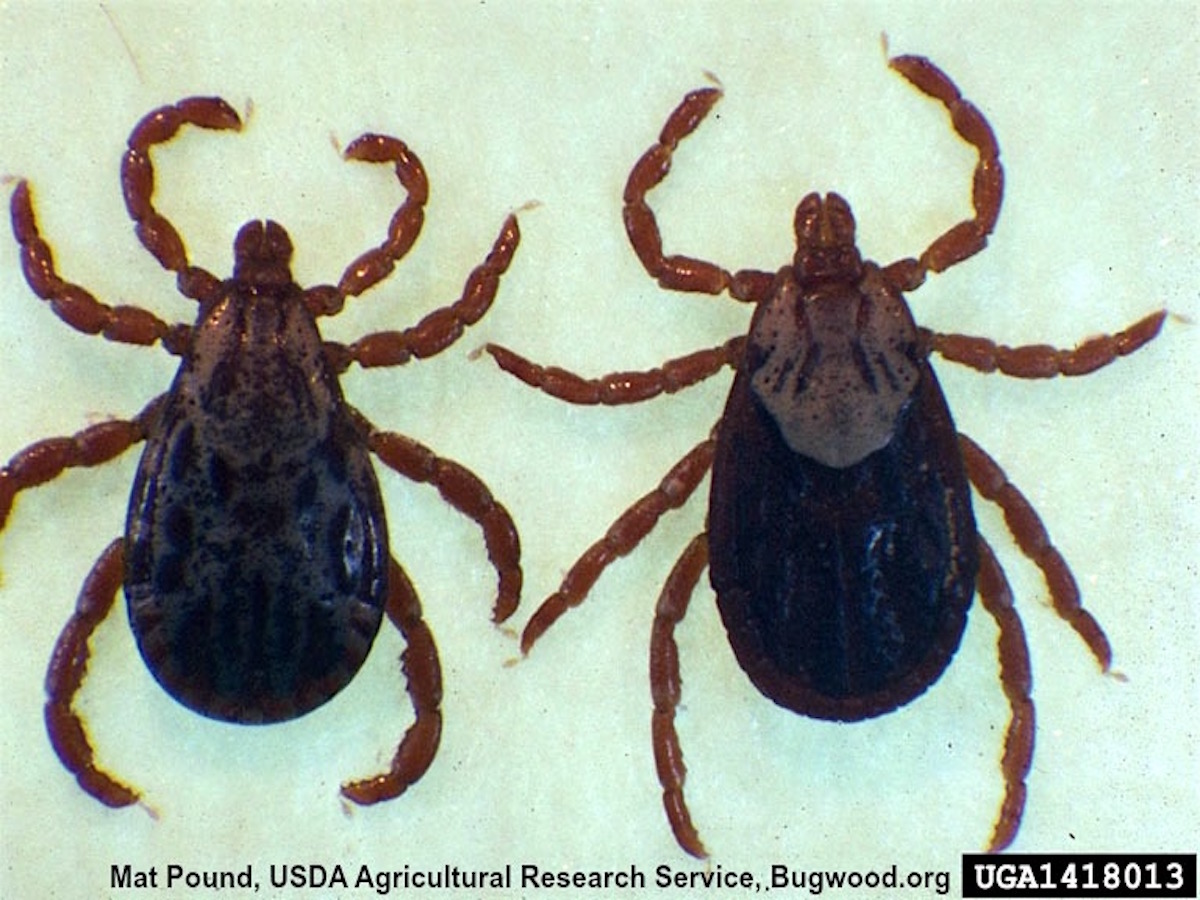
Rocky Mountain Wood Ticks Bite Removal Of Wood Ticks

Life Cycle Of Ixodes Ricinus And Transmission Of Rodent Associated Download Scientific Diagram

Keep Your Family Safe This Summer By Knowing All About Ticks Tick Prevention Tick Safety And How To Safely Remove Ticks On T Ticks American Dog Ticks On Dogs
Transmission Canlyme Canadian Lyme Disease Foundation

Tickencounter Resource Center Tick Identification Dermacentor Variabilis American Dog Tick Ticks American Dog Ticks On Dogs

Groundhog Tick Ixodes Cookei Ticksafety Com

The Typical Life Cycle Of The Black Legged Or Deer Tick Ixodes Download Scientific Diagram

How To Grow Mint From Cuttings For An Endless Supply Lyme Disease In Dogs Lyme Disease Tick Life Cycle
